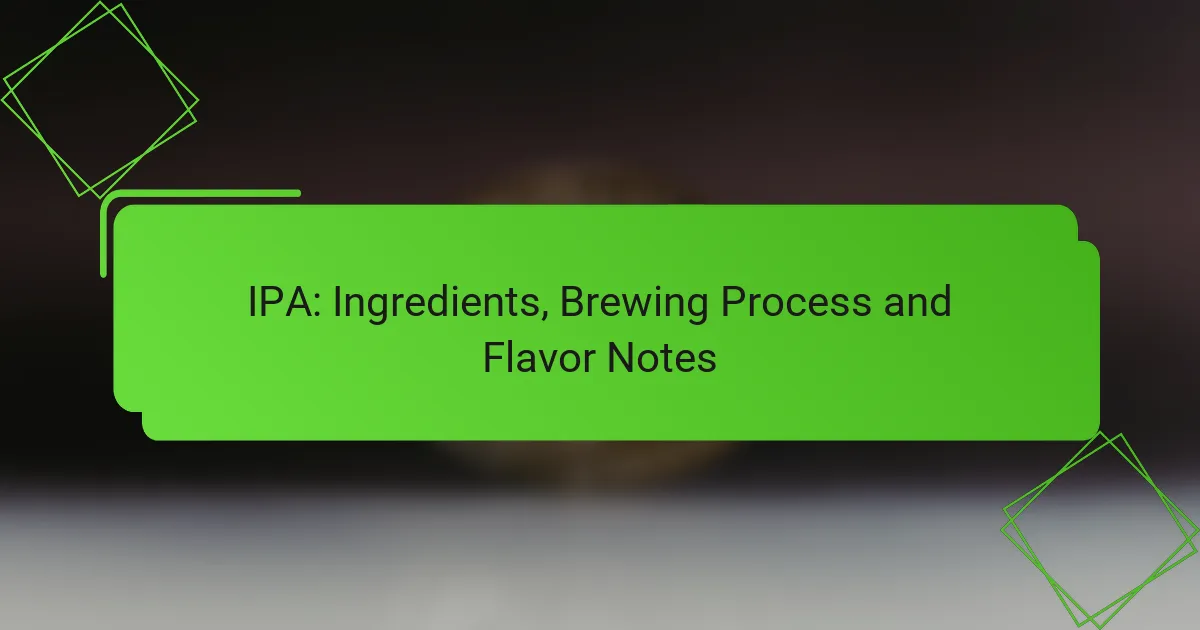India Pale Ale (IPA) is a popular beer style known for its bold hop flavors and aromas, achieved through a meticulous brewing process involving key ingredients like malt, hops, yeast, and water. The brewing steps, including mashing, boiling, fermentation, and conditioning, work together to create a distinctive taste profile that often features hoppy bitterness balanced by malt sweetness. Common flavor notes in IPAs include citrus, floral, and herbal elements, making them a favorite among craft beer enthusiasts.

What are the key ingredients in IPA?
The key ingredients in India Pale Ale (IPA) include malt, hops, yeast, and water. Each component plays a crucial role in defining the beer’s flavor, aroma, and overall character.
Malt types used in IPA
Malt provides the sugars necessary for fermentation and contributes to the beer’s body and flavor. Common malt types used in IPAs include pale malt, which serves as the base, and specialty malts like crystal or caramel malt, which add sweetness and color.
When selecting malt, consider the desired flavor profile. For a traditional IPA, a balance of pale malt and a small percentage of specialty malts typically works well, creating a solid backbone for hop flavors.
Hops varieties for flavor
Hops are essential for imparting bitterness, flavor, and aroma to IPAs. Popular hop varieties include Cascade, Citra, and Centennial, each offering distinct citrus, floral, or piney notes.
When brewing, consider using a combination of hops for both bittering and aroma. Adding hops during the boil and again during fermentation (dry hopping) enhances the beer’s hop character, resulting in a more complex flavor profile.
Yeast strains for fermentation
Yeast is responsible for converting sugars into alcohol and carbon dioxide during fermentation. Common yeast strains for IPAs include American Ale yeast, known for its clean fermentation and ability to highlight hop flavors.
Selecting the right yeast strain can significantly impact the final product. For example, using a yeast that produces fruity esters can complement hop aromas, while a cleaner strain may allow hop characteristics to shine through more prominently.
Water profile considerations
The water used in brewing can affect the taste and mouthfeel of the IPA. Key factors include mineral content, pH, and hardness. A balanced water profile with appropriate levels of sulfates and chlorides can enhance hop bitterness and malt sweetness.
When brewing an IPA, consider adjusting your water chemistry to match the style. Many brewers aim for higher sulfate levels to accentuate hop bitterness, while a balanced chloride-to-sulfate ratio can provide a fuller mouthfeel.

How is IPA brewed?
IPA, or India Pale Ale, is brewed through a specific process that emphasizes hop flavor and aroma. The brewing involves several key steps, including mashing, boiling, fermentation, and conditioning, each contributing to the beer’s distinctive taste and character.
Step-by-step brewing process
The brewing process for IPA typically starts with mashing, where crushed malted grains are mixed with hot water to extract fermentable sugars. This is followed by boiling the wort, during which hops are added at various stages to impart bitterness, flavor, and aroma.
After boiling, the wort is cooled and transferred to a fermentation vessel, where yeast is added. The yeast ferments the sugars, producing alcohol and carbon dioxide. Finally, the beer is conditioned to develop its flavors before packaging.
Temperature control during fermentation
Maintaining the right temperature during fermentation is crucial for producing quality IPA. Most ales, including IPAs, ferment best between 18°C and 22°C (64°F to 72°F). Higher temperatures can lead to unwanted esters and phenols, while lower temperatures may slow fermentation.
Using temperature-controlled fermentation vessels can help brewers achieve consistent results. Monitoring the fermentation temperature closely allows for adjustments that can enhance the beer’s flavor profile.
Common brewing equipment
Brewing IPA requires several essential pieces of equipment. A mash tun is used for mashing, while a kettle is necessary for boiling the wort. Fermentation vessels, often made of stainless steel or glass, are crucial for yeast activity.
Other common equipment includes a hydrometer for measuring specific gravity, a thermometer for monitoring temperatures, and a bottling or kegging system for packaging the finished beer. Each piece of equipment plays a vital role in ensuring the brewing process runs smoothly and effectively.

What are the flavor notes of IPA?
IPAs, or India Pale Ales, are known for their bold and diverse flavor notes, primarily characterized by hoppy bitterness and a range of aromatic profiles. Common flavor notes include citrus, floral, and herbal elements, often balanced by a degree of malt sweetness.
Citrus flavor profiles
Citrus flavor profiles are a hallmark of many IPAs, contributing bright and refreshing notes. Common citrus flavors include grapefruit, orange, lemon, and lime, which can vary in intensity depending on the hop varieties used. For instance, hops like Citra and Amarillo are particularly known for their strong citrus characteristics.
When tasting an IPA, look for the balance of citrus notes with bitterness; a well-crafted IPA will have these flavors harmonizing rather than overwhelming each other. Consider trying different IPAs to identify which citrus profiles you prefer, as they can significantly influence your overall experience.
Floral and herbal notes
Floral and herbal notes add complexity to the flavor profile of IPAs, often providing a fragrant and aromatic quality. Hops such as Cascade and Centennial can impart floral aromas reminiscent of jasmine or chamomile, while herbal notes may evoke flavors like basil or mint.
These flavors can enhance the drinking experience, especially when paired with certain foods. When sampling an IPA, pay attention to how these floral and herbal notes interact with the bitterness and malt sweetness, as they can create a more rounded flavor profile.
Malt sweetness balance
The balance of malt sweetness in IPAs is crucial for counteracting the hoppy bitterness. While IPAs are primarily hop-forward, a certain level of malt sweetness can provide a backbone that enhances the overall flavor experience. This sweetness can range from light caramel to more pronounced toasty notes, depending on the malt used.
When evaluating an IPA, consider how the malt sweetness complements the hop flavors. A well-balanced IPA will have a noticeable sweetness that supports the bitterness, making it more approachable. Look for IPAs that achieve this balance, as they often provide a more enjoyable drinking experience.

How does IPA vary by region?
IPAs, or India Pale Ales, differ significantly by region, influenced by local ingredients, brewing traditions, and climate. These variations result in distinct flavor profiles and aromas that reflect the brewing heritage of each area.
American IPA characteristics
American IPAs are known for their bold hop flavors and aromas, often featuring citrus, pine, and floral notes. The use of American-grown hops like Cascade, Centennial, and Citra contributes to their distinctive profiles, which can range from moderately bitter to intensely hoppy.
Typically, American IPAs have an alcohol content ranging from 5.5% to 7.5% ABV, making them a popular choice among craft beer enthusiasts. They often showcase a golden to amber color and a medium to high body, providing a well-rounded drinking experience.
British IPA differences
British IPAs tend to be more malt-forward compared to their American counterparts, featuring earthy and herbal hop characteristics. Traditional English hops such as Fuggles and East Kent Goldings are commonly used, resulting in a balanced flavor profile that emphasizes malt sweetness alongside moderate hop bitterness.
These IPAs generally have a lower alcohol content, typically between 4% and 6% ABV, and are characterized by a copper to amber hue. The mouthfeel is often smoother, making them approachable for a wide range of beer drinkers.
New England IPA traits
New England IPAs (NEIPAs) are celebrated for their hazy appearance and juicy, fruity flavors. This style emphasizes late hop additions and dry hopping, which enhances the aroma and flavor without adding excessive bitterness, often resulting in tropical fruit notes like mango, pineapple, and citrus.
With an ABV usually between 6% and 8%, NEIPAs are known for their soft, creamy mouthfeel and low bitterness. They often appear pale yellow to golden and are a favorite among those who prefer a less bitter, more aromatic beer experience.

What are the best food pairings for IPA?
The best food pairings for IPA (India Pale Ale) often include spicy dishes, grilled meats, and various cheeses. These combinations enhance the beer’s hoppy bitterness and aromatic qualities, creating a balanced dining experience.
Spicy food pairings
IPAs are excellent companions for spicy foods due to their hoppy bitterness, which can help cut through heat. Dishes like spicy Thai curry, buffalo wings, or spicy tacos work particularly well. The carbonation in the beer also helps cleanse the palate between bites.
When selecting an IPA to pair with spicy food, consider a fruit-forward variety, as the citrus notes can complement the heat. Avoid overly bitter IPAs, as they may intensify the spiciness rather than balance it.
Grilled meats compatibility
Grilled meats, such as burgers, ribs, and chicken, pair wonderfully with IPAs. The smoky flavors from the grill enhance the beer’s hoppy characteristics, creating a satisfying match. A robust IPA can stand up to the rich flavors of grilled meats without being overshadowed.
For optimal pairing, choose an IPA with a moderate to high alcohol content, as it can complement the richness of the meat. A West Coast IPA, known for its piney and citrus notes, is often a great choice for grilled fare.
Cheese pairings for IPA
When it comes to cheese, IPAs pair well with a variety of options, particularly sharp and tangy cheeses. Cheddar, blue cheese, and goat cheese are all excellent choices that enhance the beer’s flavor profile. The bitterness of the IPA can balance the creaminess of the cheese, creating a harmonious experience.
For a successful pairing, consider the intensity of both the cheese and the IPA. A strong, hoppy IPA works best with bold cheeses, while a lighter, more floral IPA can complement milder varieties. Experimenting with different combinations can lead to delightful discoveries.

How to choose the right IPA for your taste?
Choosing the right IPA involves understanding your flavor preferences and the characteristics of different IPAs. Consider factors like bitterness, aroma, and alcohol content to find a beer that suits your palate.
Identifying personal flavor preferences
Start by reflecting on the flavors you enjoy in other beverages. Do you prefer fruity, floral, or earthy notes? IPAs can vary widely, with some showcasing citrusy hops while others may lean towards piney or resinous flavors.
Consider the bitterness level, measured in International Bitterness Units (IBUs). A lower IBU (around 30-40) may offer a more balanced taste, while higher IBUs (60 and above) can provide a more intense bitterness. Experimenting with different styles can help you discover what you like best.
When trying new IPAs, take note of the aroma and aftertaste. Some IPAs are dry-hopped for a burst of fragrance, while others may have a lingering finish. Keep a tasting journal to track your favorites and refine your choices over time.



